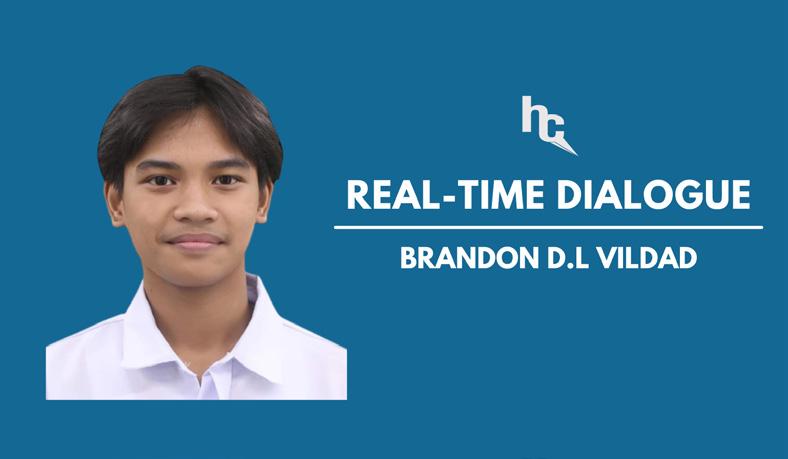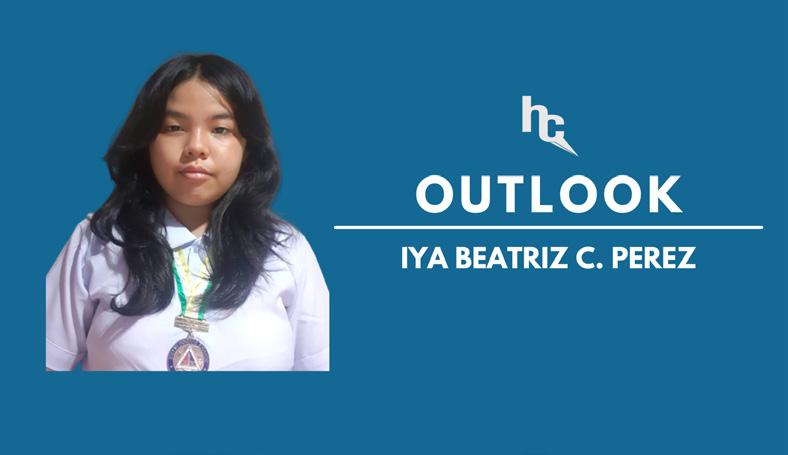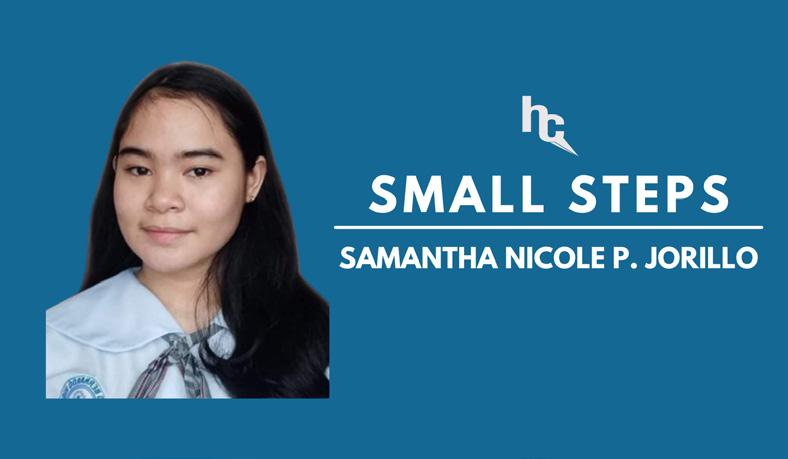
14 minute read
BENARDIANS SPEAK: What do you think of ChatGPT
To understand how they got to know CHATGPT, perceived opportunities and threats, and reasons for using it, The Hillside Chronicle conducted a semi-structured interview with five (5) learners and (5) teachers at Ponciano Bernardo High School using purposive and convenience sampling techniques. The purposive sampling was based on the participants who have used ChatGPT at least once in their education. Meanwhile, the convenience aspect of the sampling sought to engage the learners who were willing and were relatively free. Some responses in the semi-structured interview are provided in Extracts 1 to 6.
Grade 7
Advertisement
“Well, I watch a lot in Youtube. I go to a lot of social media. Somewhere, somehow, I just come across the term. I think it’s okay. It’s cool. It’s very helpful but I won’t recommend using it since it’s lessening our values. It’s lessening our opportunities to learn and to work harder for something since it’s an AI that can do things almost everything faster than us. So, we will lose the value of taking the time to work hard for something.”
Grade 8
“There was this one time that I used it to ask for information. It can tell you all the questions you ask. It is not trustworthy. It gives ideas but that’s it. If students were to use it as basis for their topics, it is not recommendable because you won’t know if it’s true or not.”
Grade 9
“It’s an AI that can give information on topics that we don’t grasp so we could widen our knowledge about them. It helps us learn topics that we do not understand.”
Grade 10
“It is an AI that can make everything you ask it for, from essays to mathematical equations. Somewhat, because when I do not understand a problem, I tend to go to the site for help, and it usually explains it better than most. As a tool, it has some benefits but if you were to abuse it, you will never learn and will continuously depend on it which in turn, will result in no learning”
Teacher
“My concerns about ChatGPT are mainly about the learning of the students, it will be compromised. In what way? Students will depend on it to create, make or to do his or her projects especially in essay writing and constructing English. Students will no longer think on their own, and depend on what the site says, and they will no longer discover their capabilities.”
Teacher
“I actually don’t have any idea about it. I just got to know about it when you told me something about it. I think that ChatGPT would be something that all students, not just the students but teachers can use. Of course, it’s just a matter of time on when the students and we, teachers learn to use it.”
“
Where are the initiatives to construct more educational facilities for students or the resolve to offer more educational resources to public schools?” dang, whose attempts to give education were highlighted in the report of Atom Araullo entitled “Letter from Tawi-Tawi.” In his report, Araullo described that teacher Sidang was “jumping on boats to visit several residences built on stilts in order to be able to teach young, intelligent students.”
Unknown Future
NELSON Mandela once said, “Education is the most powerful weapon you can use to change the world.” I have been exposed to this quotation for a very long time now. In fact, it has been incorporated into the English textbook for Grade 10 that I am using in class. In an ideal society, every learner would have access to education as a fundamental right. But that ideal society does not exist. And in our country, education is a right.
Recently, I had the opportunity to talk to the implementers of the English and Filipino literacy programs at our school. They revealed that a significant number of Grade 7 students find it difficult to read words and texts in both English and Tagalog. Data provided to me reported that the majority of the Grade 7 students who took the Philippine Informal Reading Inventory (PhilIRI) pretest last September 2022 are classified as “frustration readers,” which means that they barely understood the meaning of the texts they read. However, this is only a brief summary of the difficulties experienced by students in the Philippines. Children seldom get the chance to attend school. In remote places, for instance, volunteer teachers are required to visit each student individually, which unquestionably consumes a significant amount of their time and work in exchange for a meager budget. This was the case with the teacher Si-
Inflation to starvation
“BAKIT tumaas ang presyo?” (Why did the price hike?). This question regularly comes up when I go shopping with my parents, for some basic goods. For instance, if the cost of the meat alone is high, how much more so if the usual onions, which give your meal a fresh flavor, cost almost the same amount as the meat? Would you still buy onions, or would you wait to buy them until your next shopping trip to save money? You will think twice for sure. Onions need to be reasonably priced as they are a staple food and a key component of almost every Filipino recipe.
However, the rising cost of onions per kilogram now allowed for the feeding of an entire family. Over the previous few months, onion prices have progressively increased. It just cost 170 pesos as of last September 2022. The fact that it went from being worth 300 pesos in November to 700 pesos in December is enough to make people cry without even slicing it.
On December 7, 2022, the government announced that prices of basic goods and services in the country rose by 8 percent in November from a year ago - the fastest pace of inflation in 14 years - due mainly to higher food prices. This gloomy development comes fewer than three weeks
Teacher Feedback System: A ‘must-have’
All students should be provided with a consistent, standard method of providing feedback to their teachers so that we may practice advocating for our education to reduce missed instructional time and student dissatisfaction. For teachers and administrators to have access to this input year-round and to get notifications, students should be able to provide their feedback at any time during the school year.
Teachers have a significant impact on how their students expect to graduate from high school as they create their motivations and aspirations. No matter how effectively a teacher may teach, without the chance to openly express our concerns, students will only have a limited relationship with their teachers. Some students may feel uncomfortable asking questions or asking for help because of the lack of communication, which will impact success rates for both teachers and students.
Implementing a structured feedback system would enable teachers and administrators to identify probable reasons for lower and greater success rates. While students are aware of their areas of weakness, teachers may be unaware that certain students find their teaching to be unproductive. Because teachers may more easily learn from and enhance their teaching techniques, this knowledge will be crucial in improving educational systems.
The establishment of such a system would be essential to its success even if it would have significant advantages.
Sadly, it appears unlikely that these issues will be solved very soon. Even though the current administration allocated P852.8 billion for the education sector, vowed to prioritize skills training to improve STEM education, and vowed to review the K to 12 curriculum, these measures hardly address the prevailing problems with an education that people like teacher Sidang and her students face. It is also important to note that recent problems in the education sector have included expensive computers, confidential funds totaling P500 million, and a shortage of funding for special education. Despite a promise made by President Ferdinand “Bongbong” Marcos Jr. during his campaign, the salary increase for public school teachers has been rejected.
Where are the initiatives to construct more educational facilities for students or the resolve to offer more educational resources to public schools? This puts the future of education in our society, as well as the future of our children and young adults, who are meant to be the future of our country, in danger.
The moment has come for the current education leaders to decide on their priorities. Why not ensure that all children enjoy one of their fundamental rights, the right to education, instead of advocating for mandatory ROTC to inspire, train, organize, and mobilize the students for national military preparedness? The need to address education in our country will always be relevant and critical. This should serve as a call to the government to tackle the problems with education. Without that, the future is unknown.
The government must uphold its word and ensure that no one goes hungry.” before Christmas, when Filipino families customarily get together to enjoy the holiday season over supper with whatever feast they can afford. It is likely that there will be a little less food on tables across the nation for the Noche Buena meals.
According to the Philippine Statistics Authority (PSA), food prices were the main factor in the acceleration of inflation, which rose to 7.7 percent in October 2022 from 6.9 percent in September 2022. Prices of vegetables, tubers, etc., soared to 16 percent from 3.5 percent in September 2022, while that of meat products went up to 11.5 percent from 9 percent.

Inflation in November 2022 is at an almost 14-year high since December 2008 when it hit 7.8 percent; that year saw a financial crisis dampening economies around the world.
During the Christmas season, that piece of news does not sound merry. If onions are already considered quite expensive, how can the typical Filipino afford to eat a simple yet healthy and balanced diet?
Sadly, in this era of high costs, a healthy diet would rank low on the list of priorities for individuals who were already struggling to make ends meet. Stunting and malnutrition are problems that could only get worse as a result, particularly among children from low-income families. Hunger among the poor could possibly worsen as a result of the circumstances.
Back in August 2022, the National Economic and Development Authority committed “to ensure that there is sufficient and healthy food on the table of every Filipino” as it anticipated inflationary prices due to the Russia-Ukraine conflict and other factors.

The government must uphold its word and ensure that no one goes hungry as the Filipino people brace themselves for worse times to come.
“
We need to implement a standardized teacher feedback system to encourage students to exercise their right to speak out,”
All students should have the option of anonymity to make sure they feel comfortable providing feedback to teachers. An anonymous feature would be helpful for students who are concerned about their academic achievement in case their criticism is linked to them, particularly in competitive schools where grades are prioritized. Students may speak openly without being concerned about it affecting their results if there was an anonymous mechanism in place.
Even if exaggerated or misleading claims may be made when a student is anonymous, a large-scale system will ensure that the majority of the valid feedback much outweighs the small percentage of incorrect ones.
To that end, it is important to consider a deeper issue if students feel compelled to purposely hurt their teachers by making untrue feedback. It is equally crucial to permit administrative scrutiny. Teachers might not take feedback seriously if the administration is not keeping an eye on the system, which would be counterproductive.
Administration ought to be changed to do this if enough of the same criticism is received so they can step in.
In an ideal educational setting, connections between students and teachers would be mutually beneficial, allowing both to benefit from ongoing feedback and growth.
Generally speaking, allowing students to provide feedback to their teachers communicates to them that their problems are heard and that their perspectives are valued. Students learn to avoid conflict instead of standing up for what they believe in is right when they are penalized for expressing their valid concerns.
We need to implement a standardized teacher feedback system to encourage students to exercise their right to speak out, especially when the issues on their minds will not only affect their performance in high school but also their lives after graduation. This is especially important at Ponciano Bernardo High School, which places a strong emphasis on academic growth and stimulating learning environments.
“You’re nothing, but a second-rate trying hard copycat!” Most people have heard this iconic line made famous by Cherrie Gil in the 1985 film Bituing Walang Ningning. In fact, there have been countless parodies of this reeling scene in Filipino comic shows and even in modern Dubsmash videos.
Humans naturally desire to achieve greatness and being inspired by someone else’s accomplishment may be quite motivating. But we have all experienced the opposite side of this and know what it is like when someone claims your work as their own. This is also true for many artists who are dissatisfied with the rise in popularity of AI art generators.
According to some, utilizing this type of art for contests or business purposes amounts to theft from other artists. Defenses also point out that AI tools require far less expertise than modern art does. Additionally, conflict develops when AI-generated art is used by internet trolls as a platform to spread misleading information because AI gives people the power to create realistic-looking but fake photos. How will this impact me and other visual artists, I wonder? Art generators are not only unjust to modern artists, but they are also discouraging to potential future artists.
As a person who has considered a career in art, knowing that my work may be used in this manner makes me hesitant about choosing this path.
Not
The future of education is a topic that many people are worried about after a rapid explosion in artificial intelligence technologies. A recent development is OpenAI’s free-to-use ChatGPT assistant, which can write short stories or even code computer programs, all according to a user-specified prompt.
However, ChatGPT has faced institutions with another educational dilemma. Students may now utilize machine learning to create essays that are on par with those produced by humans in terms of quality. The Hillside Chronicle believes that artificial intelligence may improve education if utilized properly by providing important research and promoting a focus on actual, meaningful learning for students, even though ChatGPT makes it harder to detect academic dishonesty.
Hence, to understand the perception, intention, and awareness of ChatGPT among the learners at Ponciano Bernardo High School during the School Year 2022-2023, The Hillside Chronicle conducted an anonymous online closed-ended survey using Google Form which was answered by 150 learners from Grades 7 through 10. The results of the online survey were followed up using a semi-structured interview with ten (10) learners who were selected purposively and conveniently. The Hillside Chronicle discussed the findings from the analyzed quantitative and qualitative data.


Regarding perceptions, The Hillside Chronicle found that most learners expressed their opinions of ChatGPT in favorable ways. Its value in fostering students’ growth and enhancing academic activities informed the use intents. As a result, ChatGPT is pushing educational transformation and a shift away from conventional ways of instruction delivery. It is undeniable that students’ support for integrating ChatGPT into the educational system is modeled by their satisfaction with using new technologies, the im-
Anonymous participation mechanism should be implemented
The stillness in the classroom is deafening as the teacher examines the students for a response. My thoughts are racing as I consider breaking the ice with the response I am doubting. While we wait for someone to step up and offer an answer, my students make eye contact with one another. I hold my hand firmly on my desk because I am concerned about potential criticism from others.
I can count on one hand how many times I have asked a question in class throughout the past academic years. Despite my teachers’ encouragement to participate, a small number of students always wind up being the only ones.

In most cases, self-doubt persuades me that the answer I have in mind is incorrect. No matter how small, I cannot take the chance of embarrassing myself in front of 40 students and the teacher, knowing that if I provide the wrong answer, everyone will see that I was self-assured enough in my inadequate response to volunteering. At the end of the day, this nagging sense of humiliation will keep me from raising my hand again.
Even though I am confident that my peers will quickly forget about my useless response, the nagging fear that my mistakes would damage their opinion of me prevents me from speaking.
According to a 2020 study by Crizjale Ahmad entitled, “Causes of Students’ Reluctance to Participate in Classroom Discussions,” the main reason why some students avoid participating in class is the fear of embarrassment.
Furthermore, Ahmad’s research (2020), better performance in the classroom was associated with higher involvement. Academically, focus group participants who engaged in less active learning generally performed worse than those who did.
We must create a better participation system that allows students to openly share their thoughts and uses anonymity to promote involvement since engaged students do better academically.
The constant worry of being evaluated is also removed when students conceal their identities during a conversationTo implement anonymous participation, teachers should keep
I find the work involved in creating the prompts required to produce these photos to be quite intriguing. The ability to aggregate the volume of images uploaded to the web intrigues me greatly. While it is true that image warping and odd proportions are signs of AI art, technology is rapidly improving. How can AI-generated art be distinguished from works created by real artists? This is even more challenging because many AI applications do not place watermarks on artwork. This makes AI art horrifying and thrilling to think about. Given the novelty of AI, it is the misuse of art, rather than its false creation, that is where the true problem lies. Therefore, navigating this new world of AI-generated art requires clear government regulation and protection of artists’ rights to their work.
It is the misuse of art, rather than its false creation, is where the true problem lies.” proved results they bring and the excellent user experience.
From the qualitative data, The Hillside Chronicle discovered that social media has a positive impact on the learners. Evidently, as stated by the respondents, writing, mathematical, and information-seeking abilities had greatly increased. These benefits aligned with the justifications for implementing ChatGPT.
As a student, I believe AI is only a threat to education if educators and policymakers fail to see the danger that the educational system itself poses to meaningful learning.
Further, education may face risks far greater than an army of intelligent chatbots unless educators and governments overhaul present teaching methods. Education can only envision a future where learning may flourish if we are prepared to push the boundaries of tradition and strive for change. Undoubtedly, ChatGPT is the technology of the future, and we think that education needs to change to reflect that. Therefore, students should not be discouraged from using this tool. ChatGPT will support underprivileged students around the country in their quest for a better education and a better life.
ChatGPT is the technology of the future, and we think that education needs to change to reflect that.” hold of the technology we used during remote learning. We were compelled by the pandemic to adopt technology in the virtual classroom that we had never truly used before. These include the anonymous components of Pear Deck and Padlet. The greatest digital whiteboards for debates in the classroom are Padlets, whereas the best interactive slide displays for lectures are Pear Decks. As we return to the pre-pandemic ways of instruction, we must acknowledge how these tools may enhance both the teaching and learning processes.
Some would contend that engaging in public participation fosters public speaking abilities that are beneficial in the real world. Although it is true, passive participants are students who do not actively participate. Students get more comfortable with the concept of sharing their opinions with others when we enable anonymous involvement, which increases the likelihood that they will do so in a public setting.
Therefore, in order to help students learn public speaking, teachers should still include formal presentations and discussions in the curriculum. Nevertheless, the provision of an anonymous participation mechanism should be made available for students who are still having self-esteem issues during discussions.
“
The provision of an anonymous participation mechanism should be made available for students who are still having self-esteem issues during discussions.”
By Michaela M. Atencia










